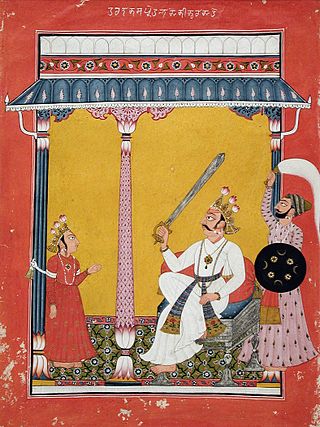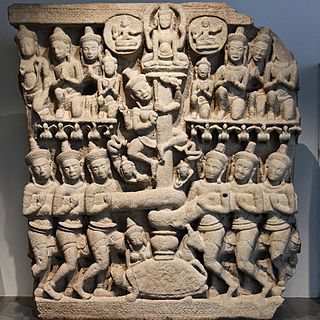Related Research Articles
Diti is a daughter of the Prajapati Daksha in Hinduism. She is a wife of the sage Kashyapa and the mother of the demonic race Daityas and the divine group of Marutas.

Prajapati is a Vedic deity of Hinduism and he is a form of Brahma, the creator god.

Hiranyakashipu, also known as Hiranyakashyap, was a daitya king of the asuras in the Puranas.

The daityas are a race of asuras in Hindu mythology, descended from Kashyapa and his wife, Diti. Prominent members of this race include Hiranyaksha, Hiranyakashipu, and Mahabali, all of whom overran the earth, and required three of Vishnu's avataras to be vanquished.

Vamana also known as Trivikrama, Urukrama, Upendra, Dadhivamana, and Balibandhana, is an avatar of the Hindu deity Vishnu. He is the fifth avatar of Vishnu and the first Dashavatara in the Treta Yuga, after Narasimha.

In Hindu literature, Andhaka refers to a malevolent asura, whose pride is vanquished by Shiva and Parvati.

Deva means "shiny", "exalted", "heavenly being", "divine being", "anything of excellence", and is also one of the Sanskrit terms used to indicate a deity in Hinduism. Deva is a masculine term; the feminine equivalent is Devi. The word is a cognate with Latin deus ("god") and Greek Zeus.
Jalandhara, also known as Chalantarana is an asura in Hinduism. He was born when Shiva opened his third eye in his fury when Indra struck him with his thunderbolt. However, Indra was saved, and the energy emitted from the eye was sent into the ocean. The energy developed into a boy and was raised by Varuna, and eventually, by Shukra. When he grew up, he conquered the three worlds - Svarga (heaven), Bhuloka (earth), and Patala (underworld). He married Vrinda, the daughter of Kalanemi. He was slain by his creator, Shiva.

Holika, also known as Simhika, is an asuri in Hinduism. She is the sister of the asura-kings Hiranyakashipu and Hiranyaksha, and the paternal aunt of Prahlada.

Hindu mythological wars are the wars described in the Hindu texts of ancient India. These wars depicted both mortals of great prowess as well as deities and supernatural beings, often wielding supernatural weapons of great power. Hindu teachings prescribe war as the final option, to be employed only after all peaceful methods are exhausted. Participation in righteous war, or dharmayuddha, was said to be honourable and was a principal duty of the Kshatriya or the warrior varna, and victory in such wars was regarded as a matter of honour.

A shaligram, or shaligrama shila, is a fossilized stone or ammonite collected from the riverbed or banks of the Kali Gandaki, a tributary of the Gandaki River in Nepal. It is also considered a form of Vishnu within Hinduism. The Kali Gandaki river flows through sacred places such as Muktinath and Damodar Kunda, enhancing the spiritual significance of these shaligrams.

Dadhichi, also rendered Dadhyanga and Dadhyancha, is a sage in Hinduism. He is best known for his sacrifice in the Puranas, where he gives up his life so that his bones could be used to manufacture the Vajra, the diamond-like celestial thunderbolt of the deity Indra, in order to slay Vritra.
Vishnu Puran is an Indian television series, by B. R. Chopra on the Hindu deity Vishnu. It is based on the Bhagavata Purana. Bhagavata Purana tells about the 10 incarnations of Vishnu, as well as other stories, such as the legend of Dhruva. The weekly series first aired Sunday morning, 23 January 2000 on Zee TV. The 124 episodes were later released on DD National.

Prahlada is an asura king in Hindu mythology. He is known for his staunch devotion to the preserver deity, Vishnu. He appears in the narrative of Narasimha, the lion avatara of Vishnu, who rescues Prahlada by disimboweling and killing his evil father, the asura king Hiranyakashipu.
Tarakasura is a powerful asura in Hindu mythology. He is the son of the asura Vajranga and his wife Vajrangi. Taraka had three sons: Tarakaksha, Vidyunmali, and Kamalaksha, who were known as the Tripurasura. He is slain by Kartikeya.

Kalanemi is an asura in Hindu mythology. He is the son of Virochana, and the grandson of Prahlada. He is slain by Vishnu in the Tarakamaya War, in which he is described to be a commander. In one of his rebirths, in various traditions, he is born as Kamsa, the son of Ugrasena, and becomes the king of Mathura. His nephew, Krishna, an avatar of Vishnu, slays him for his tyranny. Kalanemi's daughter, Vrinda, becomes Jalandhara's wife.

The Tarakamaya Wartransl. 'war over the love of Tara' is described to be an ancient conflict in Hindu mythology, instigated by the elopement of Tara, the consort of Brihaspati, by Soma, the god of the moon. It is mentioned in the Padma Purana, and described to be the fifth war in the series of Devasura Sangrama, the battles between the devas and the asuras.
Narasimha Jayanti is a Hindu festival that is celebrated on the fourteenth day of the Hindu month of Vaisakha (April-May). Hindus regard this as the day the deity Vishnu assumed his fourth avatar in the form of a "man-lion", known as Narasimha, to vanquish the oppressive asura king Hiranyakashipu and protect his devotee Prahlada. The legend of Narasimha represents the victory of knowledge over ignorance and the protection offered by God to his devotees.
References
- ↑ www.wisdomlib.org (12 April 2009). "Virocana, Virocanā: 21 definitions". www.wisdomlib.org. Retrieved 18 November 2022.
- ↑ Gopal, Madan (1990). K.S. Gautam (ed.). India through the ages. Publication Division, Ministry of Information and Broadcasting, Government of India. p. 75.
- ↑ Hudson, D. Dennis (25 September 2008). The Body of God: An Emperor's Palace for Krishna in Eighth-Century Kanchipuram. Oxford University Press. p. 225. ISBN 978-0-19-045140-0.
- ↑ Vyasa's Mahabharatam. Academic Publishers. 2008. p. 406. ISBN 978-81-89781-68-2.
- ↑ Pattanaik, Devdutt (1 September 2000). The Goddess in India: The Five Faces of the Eternal Feminine. Simon and Schuster. p. 58. ISBN 978-1-59477-537-6.
- ↑ www.wisdomlib.org (28 January 2019). "Story of Virocana". www.wisdomlib.org. Retrieved 18 November 2022.
- ↑ "Chandogya Upanishad" (PDF). Maharishi University of Management website. pp. 151–2. Retrieved 12 November 2009.
